The central downtown neighbourhood south of Jasper Avenue but north of the river valley was a small but busy hub that attracted denizens from many walks of life over the decades. These folks congregated where downtown hung over the edge of the deep plunge down Bellamy Hill Road, which curved under the hotels, towers and walkways towards the floodplain.
In the 1970s-80s, whether you were working at the first Citadel Theatre, the Edmonton Journal, Marvel Beauty Academy, or any of the nearby hotels or office buildings, or you were indulging in some after-hours socializing or illicit gay cruising, a constantly-evolving restaurant location played a central, and sometimes dramatic, role in downtown Edmonton life.
Gay restauranteur Rod Smith opened the Dapple Gray Cafe in 1981, in the current location of Chicago Deep Dish Pizza at 10024-102 street. It occupied the ground floor of the nondescript 2-story brick building, tucked behind of the multi-renovated parts of the old Edmonton Journal building. Since before the 1960s, this small building has almost been an annex to the old Salvation Army Citadel, with basement passages and doorways connecting the two structures.
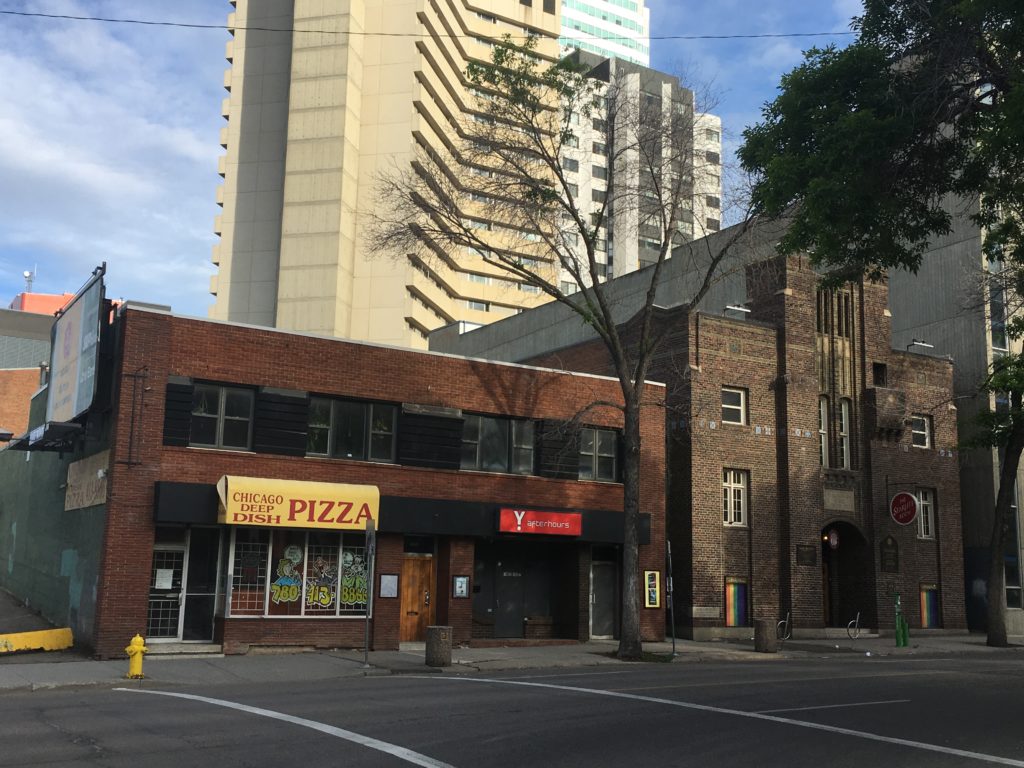
Exterior shot of 10024 102 Street, June 2020. Photo provided by author. 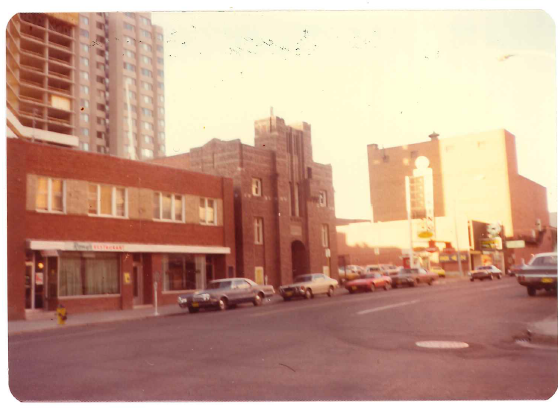
Exterior shot of Rony’s, date unknown. Photo courtesy of the management of the Starlite Room, current occupant of the former Salvation Army Citadel Theatre building.
The Dapple Gray Cafe played a brief but vibrant role in the late night gay scene, due in part to its location next door to the Marvel Beauty Academy where, by day, many a hairdresser and beautician learned their trade. It also had a convenient proximity to the then-notorious gay cruising strip along MacDonald Road, high atop McDougall Hill.
Afternoons were sunny and friendly as the cafe treated the downtown casual crowd to legendary fresh blueberry milkshakes. It was the perfect out of the way spot for fantastic eggs benny, and was the first restaurant in Edmonton to embrace the ‘farm-to-table’ style of cuisine.
But its maroon booths and a campy diner style, coupled with the fact that it was open 24-hours, also made it the perfect place to head after the queer bars closed for the night. Plus, it was right at the end of “The Hill”.
By day, MacDonald Drive was sunny and quiet, with a beautiful view of the river valley and the buzzing traffic below. By night, it was a one-way circular drive of sin. In the late 1960s, The Hill become a place where gay men would look for men like them, eventually joined by hustlers; in the late 1970s female and trans sex workers joined the crowd on The Hill. This nonstop traffic fed bars like Greenbriar a block away, with its dark smoky tavern populated by a bookie or a sex worker or a journalist or two.
When the female and trans sex workers moved further west to take over 104 street, The Hill retained its secret after-hours gay life. As the bars closed, shadows moved into position, and the one-way traffic would start to circle past the guys leaning against walls and lamp posts.
The early 1980s were at time when The Hill was often postered with bright yellow printed warnings of antigay violence. The LGBTQ community’s growing visibility was not without backlash, and the city had been rocked in May of 1981 by the Pisces Bathhouse Raid. Every queer person knew that the threat of violence was never far. There were tales of van loads of angry straight youths showing up and attacking with baseball bats. Stories of queers scattering in every direction. Still more tales of queers fighting back and straight guys fleeing.
And so, it was common – and common sense – to meet someone on The Hill, take them for coffee at the The Dapple Gray and get a good look at them before heading into the night together.
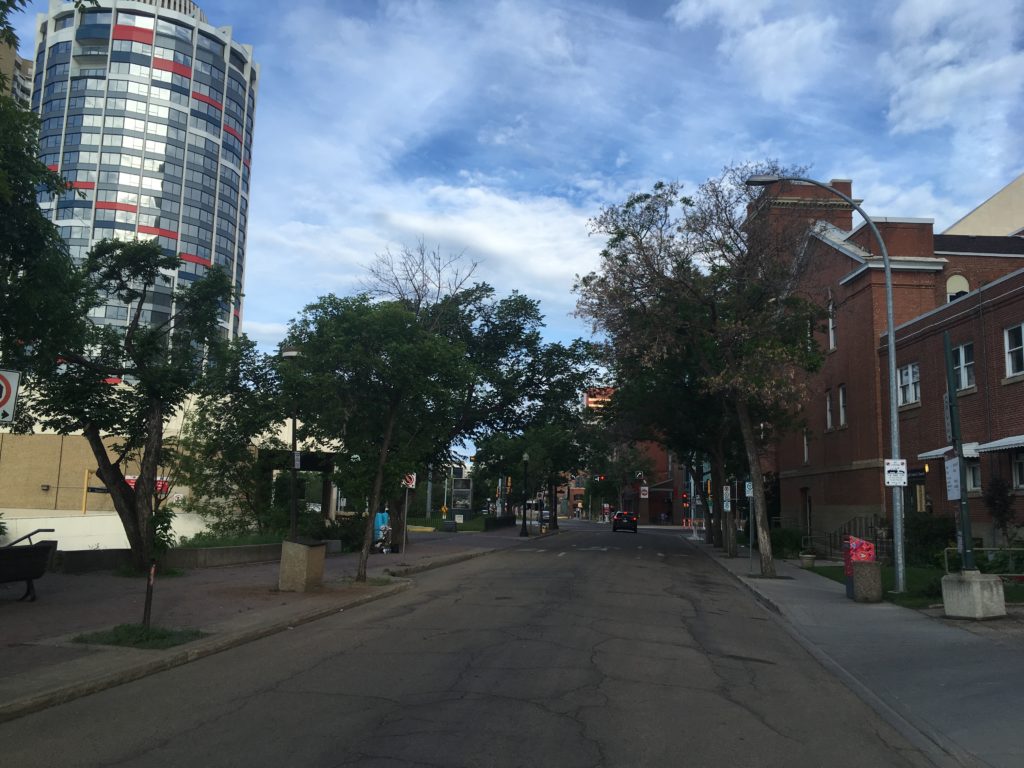
Looking west along MacDonald Drive towards 101 Street. The Chateau Lacombe is visible to the left and McDougall United Church to the right. The building once known as the Dapple Gray Café is a short walk away from MacDonald Drive. Photo provided by author, June 2020. 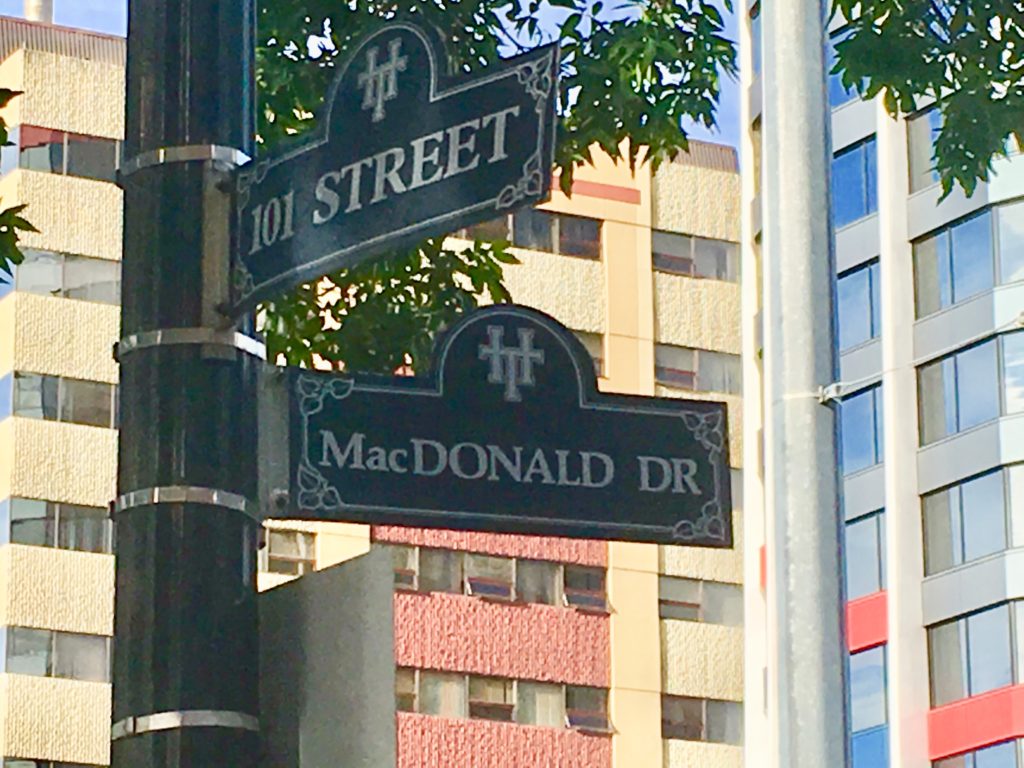
Street signs near The Hill. Photos provided by the author, June 2020.
At some point, The Dapple Gray refashioned itself as Appleby (not the chain restaurant known today). But its popularity waned, and in 1985, the Dapple Gray / Appleby closed down, prompting a small mention in the gossipy Footlights section of the Edmonton Journal, bemoaning the dusty abandoned café and noting the faded menu taped to the streaked window.
In the decades before The Dapple Gray’s brief and gay nightlife, it was, for over 30 years, a popular restaurant called Rony’s.
The 102 Street building was the second location for this classic downtown greasy spoon. According to Citadel Theatre pioneer Margaret Mooney, who worked in the theatre’s administrative offices above the restaurant from 1965-75, the owners were too stingy to pay for more than one letter of a new sign. The proof is in the old phone directory, where a restaurant called Tony’s Café at 10657 Jasper Avenue suddenly appears in 1946 as Rony’s Café at the same address, then relocates after 1960 to 102 street, taking the new sign along with it.
The head waitress was named Stella, fitting the bill of a wisecracking waitress with an eye for handsome retired baseball pitchers as if she had been sent from central casting. Reviews of the day remark on the fare available, from the thick slab of roast beef to spoonable milkshakes, and cite it as a popular lunch spot for Edmonton Journal employees.
It was in one of the upstairs offices in 1964 that an Edmonton law firm launched an annual tradition that would continue for decades: the Kosowan-Wachowich Wild Game Dinners, an exclusive invite-only affair featuring food not normally found on the Rony’s menu, but prepared in Rony’s kitchen. Lawyer Ed Wachowich was a fan of hunting, and the annual dinner was a heady mix of wild meat and legal connections. Wachowich and Kosowan would both eventually serve in the Provincial Court as Chief Judge in the 1980s.The annual dinner which was still being held around Edmonton 40 years later, became a reason to raise money for high-profile sporting charities, or fundraise to establish a new legal scholarship at the University of Alberta.
In 1965, the Salvation Army Citadel building was purchased by Joe Shoctor and became the fledgling Citadel Theatre. The administration for the theatre was housed in the offices above Rony’s. Relations between the two establishments were extremely friendly. Rony’s made a fresh batch of cinnamon buns daily, and the moment they were pulled out of the oven, Stella would call the neighbouring Citadel staff and give them a heads-up. The production manager next door would immediately call a break, rehearsal would stop, and then whole production team would head next door for their coffee break and fresh baking. It quickly became the place where theatre staff and countless creative teams would lunch daily for the next decade, until the theatre’s 1975 move to its present-day location. Then the Marvel Beauty Academy moved in next door, providing a constant feed of new customers and students. The final owners of Rony’s, a husband and wife, ran the place from 1972 to 1980.
With the closing of The Dapple Gray / Appleby in 1985, the café sat empty until sometime in 1986, when it reopened briefly as Cheddars, playing a significant role in a very different narrative.
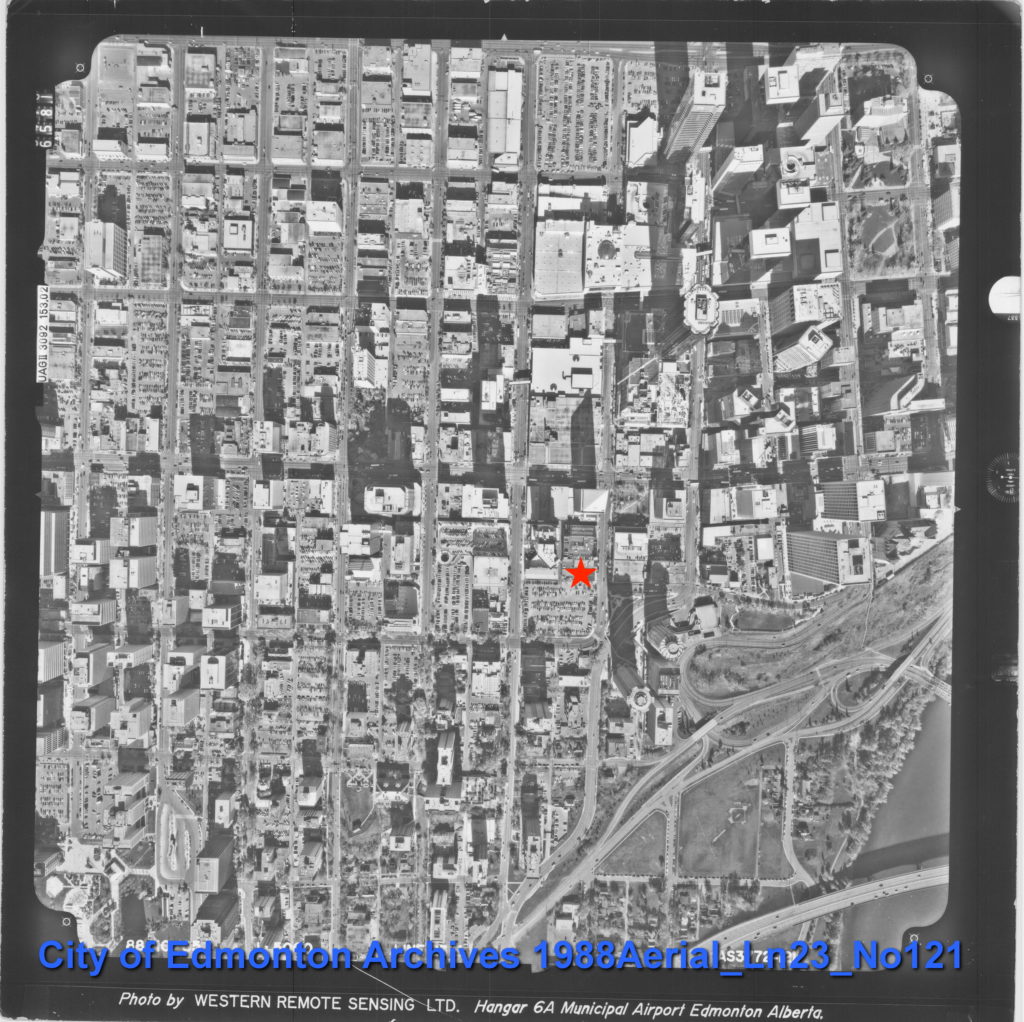
Louis Verseghy was a blackjack dealer at ABS Casino who would often head to the infamous Flashback club in the warehouse district to work as a waiter after his shift at the casino. One tragic summer evening in 1986, Verseghy took the wrong man home from the nightclub. Louis was found dead the next morning, stabbed with a knife from his own kitchen. Word swept through the tight-knit gay community that there was a murderer posing as a gay cruiser lurking in the darkness and anonymity of the scene.
The killer had been seen by a few patrons of Flashback and the community had a description. One of the people in the bar that night who had witnessed Louis leaving with the new stranger was John DiCarlo. A regular on the drag stages of Edmonton’s gay underground, DiCarlo’s drag alter ego was Lori St. John. She had even run for the position of Empress of Edmonton more than once. His day job at the time was working as a waiter at Cheddars.
The night after the murder, John was walking past The Hill on his way to work when he spotted the man that had left with Louis. In a remarkable moment of courage, he approached him, giving no indication that he knew who the man was. DiCarlo pretended to “rent” the young man for the night, but he convinced the killer to go for coffee at the restaurant first. He sat the man at a table and excused himself for a moment. Away from the table, DiCarlo called the police and turned the man in, waiting for the police to arrive and arrest the murderer. The community exhaled, relieved, but the resulting trial illuminated how vulnerable the community was to attacks from enemies, and how little protection they had from homophobic violence.
At the 1986 annual Coronation Ball, where the drag community gathered to crown its Empress, held this particular year at the Masonic Hall on 100 avenue a block from the restaurant, Lori St. John was presented with an award for bravery from the Imperial Sovereign Court of the Wild Rose, Edmonton’s drag society. She received a standing ovation.

John DiCarlo, 1988. Photo provided by the Flashback Collection. 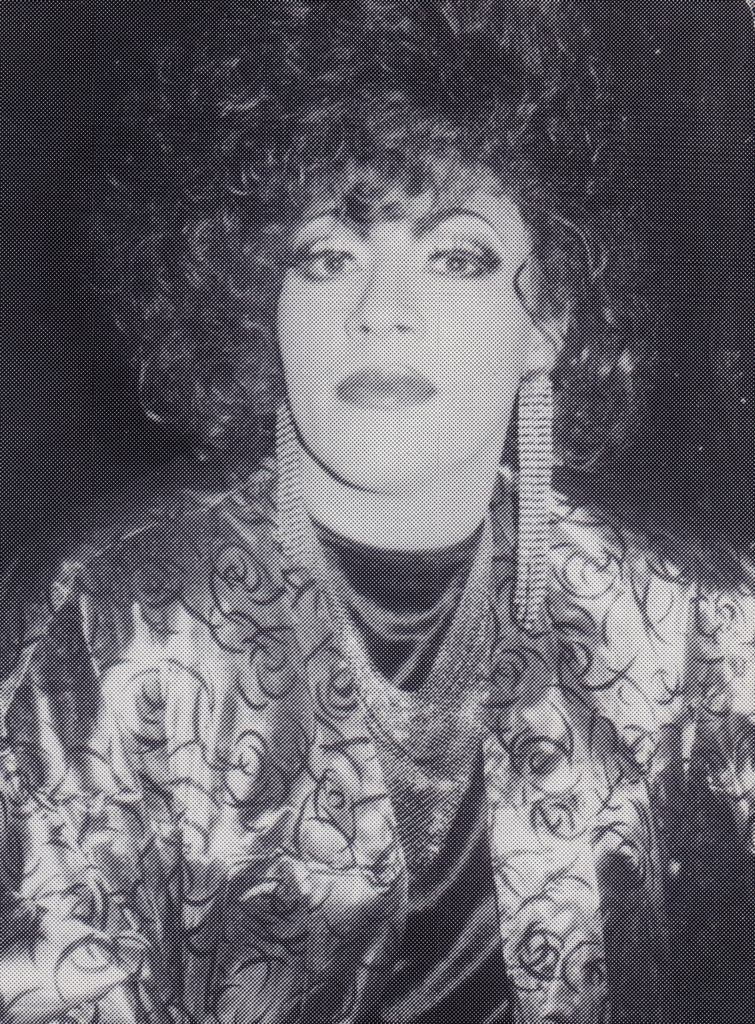
Lori St. John, 1988. Photo provided by the Flashback Collection, Empress XV, Twiggy.
Eventually, Cheddars closed its doors. The final incarnation for 10024-102 Street as a gay-friendly space was when the location reopened as Cafe Elite. Reviews from 1989 cite its reasonable prices and excellent food. It was host to an art display as part of The Works visual arts festival, and there was a mention of it becoming a live venue for acoustic music acts, before it finally closed, unable to make ends meet.
Darrin Hagen © 2020
Learn more about this area’s 2SLGBTQIA+ history on the ECAMP podcast.
